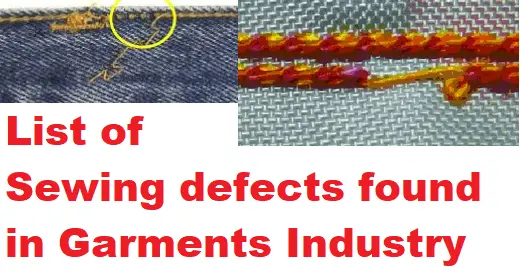Quality control is the first parameter in the garments industry. 3 major sections in the garments industry; cutting, sewing, and finishing. Sewing is the biggest section of all 3 as garments manufacturing is all about sewing. The sewing process and stitching are very sensitive and sewing machines use to sew the fabric in the garments industry. Many defects produce during manufacturing. If we can control sewing defects, 80% of defects will be reduced from the garments. So we have to reduce sewing defects to improve garments quality. It is important to know about all the sewing defects.
So, Sewing defects are created in the sewing process, here we are calling ” sewing defects” that defect created in the sewing operation. Causes are machine setting, tension adjustment, folder and guide setting, lack of operators skill, etc.

Sewing Defects List and their description of the Garments Industry
Here listed all types of sewing defects generally found in the garments industry. Skip stitches, broken stitches, and Puckering are top among all; and uncut is a common defect. Uncut thread is what leftover thread remains in the garment after stitching.
| Serial No | Defects Name |
| 1 | Skip Stitch– One stitch point skipped. |
| 2 | Broken Stitch– Stitching thread broken or torn. |
| 3 | Puckering– Stitching gathered in one place for tension or other reasons. |
| 4 | Stain/Oil mark– Machine Lubricating oil coming into contact with fabric makes an oil stain in the garments. |
| 5 | Uncut thread– Leftover thread remains in the garment after stitching. |
| 6 | Slanted/ uneven– When the stitching is not straight. |
| 7 | Hole/ Damage– Any portion of garments damaged or having holes for tearing. |
| 8 | Pleat– Having crease for the stitching process. |
| 9 | Part Shading– The color shade of two parts not matching with each other in the same garment. |
| 10 | Yarn Contamination/ Foreign Yarn – This is a fabric defect sometimes skipped in cutting inspection to catch. |
| 11 | Uneven hem, rib Stitch– The hem of shirts and pants should be even. |
| 12 | Open seam/ stitch– The stitching seam is not in the locked condition. |
| 13 | Poor neck shape/ poor shape– Shape is not matched of an operation as per garments |
| 14 | Insecure Tack/ half stitch btn– Tack is not fully stitched and not fully secured stitch to keep in locked edges. |
| 15 | Hi-low / Up Down– Two parts of the pant is up-down with each other. |
| 16 | Off shade– The shade in the garments is not matching with the buyer-approved sample. |
| 17 | Join Stitch– Two stitch joins before ending a stitching operation. |
| 18 | Crash mark/ crease mark– Having wrinkles in the garments. |
| 19 | Raw-edge– |
| 20 | Asymmetrical armhole |
| 21 | Wavy Nack Shape / Deform |
| 22 | Looseness– The tension is not correct in a stitch. |
| 23 | Roping |
| 24 | shoulder up down |
| 25 | v tack slanted |
| 26 | Press Mark |
| 27 | Twisted Seam |
| 28 | Foreign Fibers |
| 29 | Bottom Hiking |
| 30 | Wrong Mending |
| 31 | Dirty Spot |
| 32 | Needle Drop |
| 33 | Pull Yarn |
| 34 | Others sewing problem |
- Additionally, You may love to read: Stitching: Sewing Defects in Garments
- Sewing Defect with Root Causes and Corrective Actions
- Sewing Department in Garments Industry
